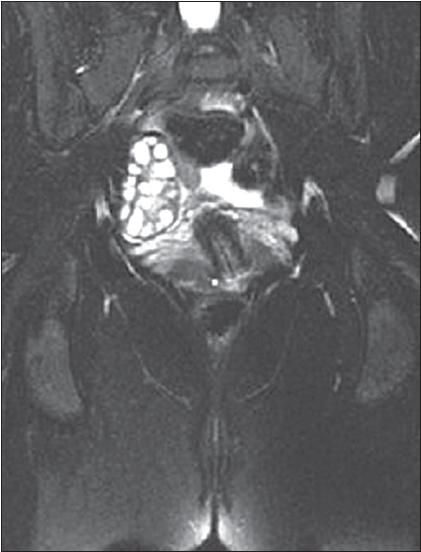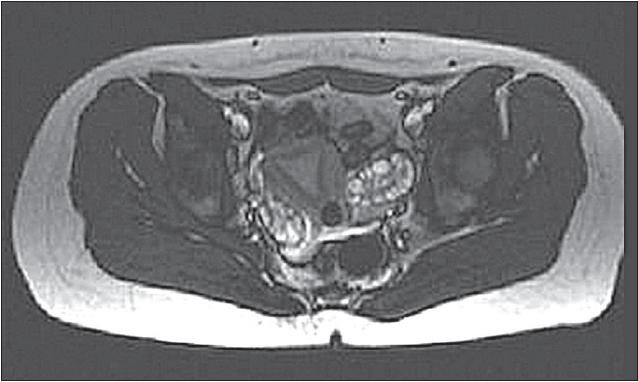Polycystic Ovary Syndrome
A 13-year-old girl presented to her primary care pediatrician for continuing evaluation of intermittent right lower quadrant and right hip pain of 7 months' duration. As part of the workup, a pediatric orthopedist had ordered an MRI scan of her pelvis. The findings were normal except for the presence of multiple ovarian follicles bilaterally (Figures 1 and 2).
A 13-year-old girl presented to her primary care pediatrician for continuing evaluation of intermittent right lower quadrant and right hip pain of 7 months' duration. As part of the workup, a pediatric orthopedist had ordered an MRI scan of her pelvis. The findings were normal except for the presence of multiple ovarian follicles bilaterally (Figures 1 and 2).

Figure 1 – This coronal T2-weighted MRI scan of the pelvis demonstrates innumerable Subcapsular follicles in the left ovary. The follicles replace most of the normal ovarian tissue and measure about 6 mm each.

Figure 2 – This axial T2-weighed MRI scan of the pelvis shows multiple subcapsular follicles in both ovaries. The ovaries measure 4.5 to 5 cm bilaterally.
The patient's height was 161.8 cm (75th percentile), weight was 75 kg (above the 95th percentile), and body mass index was 28.6 kg/m2 (above the 95th percentile). Menarche began at age 10 years. She reported having amenorrhea for 4 months and mood swings.
She appeared well, had moderate acne on her forehead and chin, a few prominent hairs above her upper lip, a small linear patch of hyperpigmentation on her neck, and obvious abdominal obesity; there was no thyromegaly. Abdominal and musculoskeletal examinations, including evaluation of the hips, were normal.
Autoimmune thyroiditis (AIT) had been diagnosed about 1 year earlier during a workup for fatigue. Antithyroglobulin antibodies were detected at a level of 286 IU/mL (reference range, less than 40 IU/mL). Thyroid replacement therapy was unnecessary because the thyroid-stimulating hormone and free thyroxine levels were normal and have remained normal; the fatigue, which was probably caused by a self-limited viral infection, resolved.
Review of the patient's clinical symptoms and MRI findings pointed to a diagnosis of polycystic ovary syndrome (PCOS).
Daily hormonal therapy with combination estrogen and progesterone was prescribed, and lifestyle changes, which included increased physical activity and a more nutritious diet, were initiated. The patient's pain, menstrual irregularity, and mood swings abated within 3 months.
POLYCYSTIC OVARIES: AN OVERVIEW
PCOS is characterized by chronic anovulation, hyperandrogenism, and polycystic-appearing ovaries. The PCOS diagnosis is determined by a constellation of clinical, laboratory, and radiological findings in a female patient of reproductive age.
In a review by Porter,1 the controversies involved in diagnosing PCOS are described, along with the criteria established in 1990 by the NIH and in 2003 by the Rotterdam workshop.2 The NIH diagnostic criteria for PCOS required all of the following:
- Chronic anovulation.
- Clinical or biochemical evidence of hyperandrogenism.
- Lack of another endocrine disorder.
The Rotterdam criteria required 2 of 3 criteria:
- Anovulation.
- Hyperandrogenism or polycystic ovaries on ultrasonogram.
- Lack of another endocrine disorder.
The Rotterdam definition potentially includes more patients (ie, those without androgen excess).
The associated clinical findings and symptoms of PCOS include menstrual irregularity, infertility, effects secondary to excess androgens (hirsuitism, male-pattern alopecia, acne), obesity, fatigue, and acanthosis nigricans. PCOS may affect up to 10% of premenopausal women. It may be on the rise in adolescents because of the increasing obesity epidemic in children.3
Laboratory findings in a patient with PCOS may include hyperinsulinemia and elevated levels of luteinizing hormone (LH), testosterone,dehydroepiandrosterone sulfate (DHEAS), 17 hydroxyprogesterone (17-OHP), and estrone. Insulin resistance also goes hand-in-hand with PCOS.4
Transvaginal ultrasonography is the radiological study of choice to evaluate the ovaries for the number of follicles, size, and stroma.5 According to Adams and colleagues,6 polycystic ovaries are identified by the presence of 8 or more peripheral follicular cysts (10 mm or smaller) and increased central ovarian stroma. In most instances, an ultrasonogram is not needed for diagnosis and an MRI scan is typically not included in the workup of a patient with suspected PCOS; however, MRI can provide very clear images of polycystic ovaries, as shown in Figures 1 and 2.
Yoo and colleagues7 concluded that compared with ultrasonography, MRI provides greater delineation of the structural components of the ovary in obese girls with PCOS. On MRI, a functional cyst would appear as a single dominant cyst as opposed to multiple cysts involving both ovaries, which are seen in patients with PCOS.
Prompt recognition and treatment of PCOS in the young adolescent is essential for abatement of symptoms. The goal of therapy is to restore menstrual cycles and reduce signs of hyperandrogenism. Current interventions include lifestyle modifications (increased exercise, weight reduction), oral contraceptives, and metformin for those patients with insulin resistance.8
AUTOIMMUNE THYROIDITIS AND PCOS
The association of PCOS and AIT has been described mainly in women in the third decade of life or older.9-11 In a prospective multicenter study that included one 16-year-old patient, Janssen and colleagues10 revealed a 3-fold higher prevalence of AIT in patients with PCOS compared with age-matched controls. Elevated levels of thyroperoxidase or thyroglobulin antibodies were found in 47 (26.9%) of 175 patients with PCOS compared with only 14 (8.3%) of 168 controls.10 More than 40% of patients with PCOS also had hypoechoic tissue typical of AIT on ultrasonograms of the thyroid. The thyroid findings correlated to some degree with an increased estrogen to progesterone ratio.10 Janssen and colleagues10 suggest screening all patients with PCOS for thyroid dysfunction and thyroid-specific autoantibodies even when there is no evidence of overt thyroid dysfunction; however, this practice is not widely recommended.
The increased prevalence of AIT in PCOS is possibly explained by an imbalance of estrogen and progesterone. 10,11 Patients with PCOS have anovulatory cycles, which result in low to no progesterone levels and elevated estrogen levels. Lee and colleagues11 suggest that depletion of progesterone from anovulatory cycles in patients with PCOS may act as an immune system stimulant, which leads to AIT; likewise, restoration of ovulatory cycles may prevent AIT in patients with PCOS. They propose that the association between PCOS and AIT may be secondary to a common genetic defect, although the specific defect is still unknown.11
SYNOPSIS
Although disorders such as hypothyroidism and other endocrine abnormalities (congenital adrenal hyperplasia and hyperprolactinemia) can lead to polycystic ovaries, PCOS was the most likely diagnosis in this case. We believe the right lower quadrant pain and right hip pain in this patient was related to the PCOS/ menstrual irregularity; the pain resolved with adherent oral contraceptive treatment. Although the patient had a diagnosis of autoimmune thyroiditis, results of thyroid function tests were within the normal range. An evaluation of this patient by an endocrinologist, after hormonal therapy was initiated, revealed normal serum levels of 17-OHP, testosterone, prolactin, free thyroxine, and thyroid-stimulating hormone.
Acknowledgments: The authors would like to acknowledge Stephany S. Swart, MD, associate professor of radiology, for her assistance with the figures and figure legends.
References:
1.
Porter MB. Polycystic ovary syndrome: the controversy of diagnosis by ultrasound.
Semin Reprod Med.
2008;26:241-251.
2.
The Rotterdam ESHRE/ASRM-Sponsored PCOS consensus workshop group. Revised 2003 consensus on diagnostic criteria and long-term health risks related to polycystic ovary syndrome (PCOS).
Hum Reprod.
2004;19:41-47.
3.
Hassan A, Gordon CM. Polycystic ovary syndrome update in adolescence.
Curr Opin Pediatr.
2007;19: 389-397.
4.
Ehrmann DA. Polycystic ovary syndrome.
N Engl J Med.
2005;352:1223-1236.
5.
Bili H, Laven J, Imani B, et al. Age-related differences in features associated with polycystic ovary syndrome in normogonadotrophic oligo-amenorrhoeic infertile women of reproductive years.
Eur J Endocrinol
. 2001;145:749-755.
6.
Adams J, Franks S, Polson DW, et al. Multifollicular ovaries: clinical and endocrine features and response to pulsatile gonadotropin releasing hormone.
Lancet.
1985;2:1375-1379.
7.
Yoo RY, Sirlin CB, Gottschalk M, et al. Ovarian imaging by magnetic resonance in obese adolescent girls with polycystic ovary syndrome: a pilot study.
Fertil Steril.
2004;84:985-995.
8.
O'Brien RF, Emans SJ. Polycystic ovary syndrome in adolescents.
J Pediatr Adolesc Gynecol.
2008;21: 119-128.
9.
Goi R, Matsuda M, Maekawa H, et al. Two cases of Hashimoto's thyroiditis with transient hypothyroidism.
Intern Med.
1992;31:64-68.
10.
Janssen OE, Mehlmauer N, Hahn S, et al. High prevalence of autoimmune thyroiditis in patients with polycystic ovary syndrome.
Eur J Endocrinol.
2004;150:363-369.
11.
Lee SH, Kim MR, Kim JH, et al. A patient with combined polycystic ovary syndrome and autoimmune polyglandular syndrome type.
Gynecol Endocrinol.
2007;23:252-256.
Newsletter
Access practical, evidence-based guidance to support better care for our youngest patients. Join our email list for the latest clinical updates.